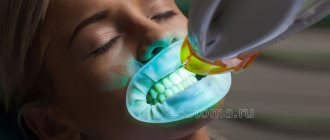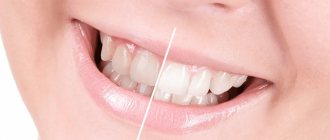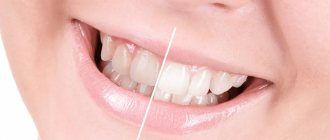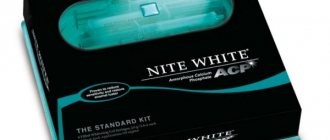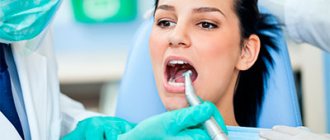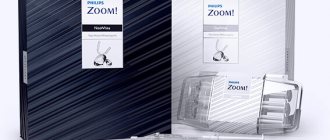Indications Is bleaching harmful?
Why do teeth darken? Whitening methods Safety of home whitening Whitening in dentistry Stages Care A snow-white smile is the dream of every person. And everyone is interested in safe teeth whitening. Many people have heard about bad experiences from friends and the Internet and are afraid to repeat these mistakes. But the procedure has been well studied, but it is important to know which Moscow clinic can provide truly high-quality and gentle teeth whitening.
Is whitening safe?
What is teeth whitening? This is a cosmetic procedure in which the color of dentin changes (namely, the color of the tooth depends on it) - lightening by several tones under the influence of active substances. Whether it is safe or not depends on the professionalism of the dentist, as well as on the technologies and drugs that are used for these purposes (these must be registered drugs, modern methods). If we are talking about whitening at home, everything is the same, only instead of a doctor, it is the rationality of a person.
ROOTT Clinic expert on the most important things when whitening
In general, whitening is a fairly safe procedure if the teeth have good mineralized enamel, healthy gums and good oral hygiene.
How to whiten teeth
Conventionally, all lightening methods can be classified into:
- professional (performed by a doctor);
- non-professional (they are also home-made).
The first include:
- photobleaching;
- laser;
- chemical;
- endobleaching;
- homemade using individual caps.
Each of these methods has its own advantages and disadvantages.
When talking about the second - unprofessional - methods, doctors mean:
- the use of pharmaceutical pastes, pencils, strips containing lightening components;
- wearing universal mouthguards purchased without a dentist’s prescription.
Unprofessional methods cannot be called safe. Their uncontrolled use often results in a significant increase in sensitivity and the development of other negative complications. The exception is brushing your teeth with a whitening paste selected by your dentist. But it is permissible to use such a composition strictly in courses, and not on an ongoing basis.
Indications and contraindications
Most often, the patient prescribes the indication for whitening to himself - he is not satisfied with the aesthetic appearance of especially the front teeth, which are visible when smiling. I want it to be whiter and more dazzling.
Darkening of the enamel can also occur due to frequent intake of coffee, cigarettes, dark berries and even medications.
But there are also a number of contraindications
:
- pregnancy and lactation;
- age under 18 years;
- allergies to drugs;
- the presence of fillings, crowns, veneers (they simply do not whiten);
- bracket systems, staples;
- cancer;
- hypersensitivity;
- active caries, periodontitis or other oral diseases;
- wedge-shaped defect (dentin exposed);
- rapid abrasion of enamel;
- in some cases diabetes mellitus.
You should definitely consult with your doctor about indications and contraindications so that together you can choose a safe method for teeth whitening. And of course, carry out a complete sanitation of the oral cavity to avoid uneven color after the procedure.
Before-after photos of teeth whitening at the ROOTT clinic
Contraindication to bleaching with soda
Dentists advise that before starting the whitening procedure with soda, visit the dental office and check the health of your teeth.
Also, this method of whitening, like some other methods, is not recommended for those who:
- have periodontal disease;
- gums bleed;
- ulcers and stomatitis are observed in the oral cavity;
- teeth are overly sensitive;
- tooth enamel is very thin;
- superficial caries is observed or molars are affected;
- There are crowns in front, which will become even more noticeable after the whitening procedure.
What harm can bleaching cause?
The safest teeth whitening will be under the supervision of a professional dentist. Indeed, with inept management and the wrong approach, a number of troubles can arise:
- Negative effects on tooth enamel of incorrectly selected concentrations of bleaching agents. This is both increased sensitivity and an increase in the microporosity of its structure. Over time, the ingestion and accumulation of food dyes may cause the tooth color to become even darker than before;
- chemical burn of gum tissue due to improper isolation;
- uneven lighting.
Teeth whitening at home with soda: methods of application
Dentists do not recommend using pure soda for teeth whitening, which can have a negative effect on the enamel. Therefore, if you decide to use soda to make your teeth white, supplement it with various substances.
- Baking soda and hydrogen peroxide. Prepare a solution of three percent hydrogen peroxide and soda (mix until smooth) and brush your teeth (brush for no longer than 3-4 minutes). Then rinse your mouth and brush your teeth with fluoride paste.
- Soda with lemon juice. Sprinkle a little baking soda on a damp toothbrush (you can use a cotton pad) and add a couple drops of lemon juice. Wipe or brush your teeth with the resulting product, then rinse with water.
- Soda and strawberries. Mash a couple of ripe strawberries and add a pinch of soda to the pulp. Apply the resulting substance to the entire dentition using a soft brush, leave for five to eight minutes and rinse. Rinse your mouth with filtered water (you can use boiled water) and clean your mouth with fluoride paste.
- Soda and iodine. This remedy has proven its effectiveness not only in the fight against plaque, but also against tartar and bacterial diseases of the oral cavity. To prepare a slurry of optimal consistency, you need to take a teaspoon of soda, add a couple of drops of iodine to it and mix with a toothpick or match. For best effect, you can hold the product on your teeth for a couple of minutes. Then rinse and rinse thoroughly, brush your teeth with regular or fluoride-containing toothpaste. Attention: this remedy is not suitable for allergy sufferers or those with endocrine diseases.
- Soda and vinegar. Mix these two substances until a homogeneous paste is obtained. Apply it to your teeth using a cotton pad, brush or fingers, and massage gently for several minutes. Rinse and rinse mouth thoroughly.
- Soda with peroxide and lemon. Take half a teaspoon each of lemon juice and soda, add five drops of peroxide (three percent). Using your finger, apply the product to your teeth and distribute evenly. Try not to get it on your gums. Wait a couple of minutes and rinse off using warm water. Brush your teeth and rinse your mouth well.
- Soda and toothpaste. Add soda to regular toothpaste, mix and brush your teeth as usual.
- Soda and activated carbon. Grind activated carbon, mix with soda (in equal proportions), add two drops of hydrogen peroxide and lemon. Brush your teeth with the resulting mixture, then rinse with warm water several times.
Regardless of the whitening method you choose, remember that using soda frequently is unacceptable. After the procedure, it is not advisable to drink hot and cold drinks (at least for an hour), and give up strong tea, coffee, wine and cigarettes for at least a day in order to maintain the whitening effect. There are other methods of teeth whitening, such as whitening gels.
If these methods seem ineffective to you, try ASEPTA PLUS Gentle Whitening toothpaste. The enzyme papain included in its composition effectively breaks down plaque, and pyrophosphates dissolve the mineral component of deposits on the teeth. Your smile will become snow-white!
What whitening methods are there?
The dentist will advise which teeth whitening is safe for each patient individually. But everything that takes place under the supervision of a doctor will definitely not harm - there is no doubt about it, especially when using the latest technologies, delicate compounds and modern developments.
Professional teeth whitening methods:
- Photobleaching;
- laser whitening;
- whitening gel only;
- hardware method.
The first two methods use a lamp or laser as a catalyst for the action of the whitening gel.
Photobleaching, for example, ZOOM, enhances the effect of active hydrogen peroxide, helping to quickly break it down into free radicals - oxygen atoms. of up to 10 tones occurs.
. With proper care, the results last for several years.
The laser procedure differs in that instead of a light beam, a laser beam acts. It can heat the surface, which causes sensitivity (everything is in the hands of a professional doctor, since the advantage of a laser is accuracy), and copes well with changing color by 10-12 tones
and maintaining it for up to 5 years. The downside is the high cost of the method.
Dentists are still arguing about what is the safest teeth whitening, and whether laser and light are necessary for the best results. But it has been proven that the method of applying gel without using them is also effective. Opalescence technology with 40% hydrogen peroxide in the gel is cheaper in price and has proven itself in aesthetic dentistry.
A simple dental cleaning at the clinic is often sufficient for many people. After removing stones and plaque, the teeth become several shades lighter. Using one of these methods:
- Air-Flow hardware cleaning (the principle is similar to a sandblasting machine, but instead of sand, soda);
- ultrasound.
You can be satisfied with the result of your renewed smile.
Rules of application
To achieve white teeth without damaging the enamel layer of the tooth, you need to use sodium bicarbonate a maximum of once a month. In this case, you need to use it mixed with water, the consistency should be mushy. You can use any other solvent.
Attention! Do not use dry soda under any circumstances; it can leave scratches on the enamel layer.
This is what the paste should look like
In addition, dry soda powder feels like sand in the mouth, which causes discomfort. It is better to use the product in diluted form, mixing it with toothpaste or other substance.
There are several proven recipes for preparing homemade soda pastes and solutions, which will be discussed below.
The method of brushing your teeth can be standard, but it is better to use circular movements of the brush. This will not only clean the tooth surfaces, but also massage the gums, improving tissue trophism.
Is it possible to whiten teeth safely at home?
The market offers more and more varieties of home whitening methods, whether they are safe or not - everything is individual. And the course usually lasts 10-20 days. However, not everyone is of any use.
Manufacturers offer:
- Whitening strips;
- mouth guards with active composition;
- felt-tip pens, markers;
- toothpastes with whitening effect.
All products contain the same hydrogen peroxide, but in a much lower concentration. Therefore, it will be possible to lighten and visually change the color of the enamel by 1-2 tones.
Rather, this is a lightening procedure, that is, you can safely bleach if you agree to change the shade by just a couple of tones, and are willing to spend a lot of time for a relatively small result.
But using professional products at home is not recommended. Is it dangerous.
Safe brushing of teeth with baking soda
In this case, a soda solution is used. It is prepared from 1 tsp. soda powder and 250 ml of warm water. You need to moisten your toothbrush in it and brush your teeth. Compared to other methods, this method is more gentle. To achieve a whitening effect with it, you need a longer time.
Whitening Recommendations
A lasting result without harm to the teeth is achieved by following several rules:
- The frequency of use of the above methods should not exceed 1 time every 7-10 days. Daily use of soda is prohibited.
- In the intervals between procedures, you need to brush your teeth with toothpastes high in minerals; products with fluoride are excellent.
- If after several procedures your teeth become too sensitive, then you should stop whitening them and switch to pastes that strengthen the enamel.
- Whitening with soda should be done using a cotton swab, disc or gauze piece. A toothbrush can aggravate the effects of abrasive components.
Safe whitening steps
- It is necessary
to carry out professional oral hygiene a few days - Isolation of soft
gum tissue. If you isolate the gum incorrectly, the patient will receive a severe burn, which will lead to complications. Therefore, safe teeth whitening in dentistry should only be carried out by an experienced doctor specializing in this field. - A special gel
based on hydrogen peroxide is applied. It is updated every 15 minutes: it is removed from the surface of the teeth (as it develops its properties) and a new portion is applied. The gel is changed three times. - Activation of the gel using a special lamp
. The dentist places a special lamp, the light of which will activate the gel. It is necessary to speed up the procedure and reduce it to 1 hour. The lamp has a cold LED light that does not heat the enamel structure and the procedure is comfortable for the patient. - Removing gel
from the enamel surface and all insulating materials from the gum surface. - Procedure for strengthening teeth
. A gel is applied that strengthens tooth enamel and reduces sensitivity.
Whitening is carried out in the smile zone, from 5 to 5 teeth of the lower and upper jaw. The procedure takes on average 1 hour
. Anesthesia is not given. This is necessary so that there is direct contact between the patient and the doctor, and the former can report if discomfort or pain occurs. Otherwise, you may miss the moment when something went wrong: a burn to the mucous membrane, too aggressive exposure to the material, a person’s low pain threshold.
Baking soda is a long-known teeth whitening remedy.
Baking soda has long been used as an effective and inexpensive means of quickly achieving a whitening effect. Even many famous personalities, for whom the appearance and condition of their teeth are very important, claim that they brush their teeth with soda, sometimes adding fresh strawberries or other fruits to the mixture. This remedy helps in the fight against tarnishing of enamel, which appears due to drinking coffee or smoking. Baking soda also has an antiseptic effect, so it is often used to cleanse and disinfect the oral cavity. If your tooth hurts, a soda solution will help relieve the pain. Baking soda is effective for gum disease and to prevent oral diseases.
So, representatives of traditional medicine recognize the option of teeth whitening using soda, believing that it is absolutely safe and effective. But dentists have a diametrically opposite opinion on brushing your teeth with soda.
Effective dental techniques you can trust
If you decide in favor of whitening, you need to make an appointment with your dentist. The doctor will talk about possible complications and explain what the final result will be. The patient must understand that the restorations in his mouth - implants, crowns, bridges, fillings - will not change their color. If they are in the smile area, they may need to be replaced.
Let's list the best modern whitening methods, starting with the most effective:
- Laser. To some extent, it can even cope with gray tetracycline crowns. In one session you can lighten the tooth surface by 10-12 tones. The doctor processes each unit separately, so that not a single untouched area is left, the mucous membranes are not damaged or overheated. A reagent is applied to the crown, which is catalyzed by a laser beam.
- Photobleaching. The teeth are covered with gel from the front side. Then an ultraviolet lamp is directed onto the jaws. The session lasts from fifteen minutes to half an hour. During this time, you can lighten your smile by 8-10 tones.
- Chemical. Today it is not as popular as it was a few years ago, but not because of low efficiency, but because of the emergence of more modern techniques. Does not involve the use of laser or ultraviolet rays. With it you can lighten crowns by 5-7 tones.
- In-canal. Indicated if the color of the unit has changed after filling with a coloring material. The doctor makes a hole and places brightening dental material into it. Then he places a temporary filling. When the expected aesthetic effect is achieved, the temporary restoration is replaced with a permanent one.
The home method requires the manufacture of personal trays. They are made from casts of the upper and lower jaws. The doctor selects a lightening gel and tells you how to use it. The patient must follow the instructions. Under no circumstances should you increase the time you wear the aligners, as this can negatively affect the condition of the enamel and lead to a destructive process. Then, instead of a radiant smile, the person will receive hypersensitive teeth that require urgent treatment.
The downside to the home program is that it is time consuming. If in-office whitening gives excellent results in one to three sessions, then you need to wait at least several weeks, more often a whole month. For many people this period is too long.
Reviews
Below are some reviews. If you have something to say, leave your feedback in the comments below the article, it will be useful to our readers.
Sergey, 45 years old, Samara . At a certain point, plaque began to bother me, and later caries. I went to the clinic, the doctor suggested an expensive paste and ultrasonic cleaning. I decided to try baking soda. The effect did not appear immediately, but after 5 applications the plaque began to gradually disappear, and the bad breath disappeared.
Tatyana, 27 years old, Yemanzhelinsk . I am a lover of strong coffee, so I have been drinking it all my life. I noticed that my teeth were getting darker and started looking for teeth whitening products. While on the form, I came across an article that talked about brushing your teeth with soda. I decided to try it. I cleaned it once a week so as not to damage the enamel. I was pleased with the result.
Indications
Enamel becomes unhealthy due to various factors. Teeth become yellow or dark. The main reasons are :
- lack of oral hygiene;
- coffee, tea and smoking prevent the appearance of plaque;
- silver amalgam filling;
- an injured tooth with a damaged neurovascular bundle;
- drinking water with the maximum amount of fluoride.
Important! This remedy can be used by those who suffer from yellow plaque, unpleasant odor and caries.
If a person has tartar, then baking soda powder will help get rid of it. The product can remove even hardened plaque.

